Much like the Elnu application that was posted earlier, I have the Nulhegan application. To view it in its’ entirety without comments, go to the link below:
Draft Nulhegan Review
See below for my commentary on this application.
Disclaimer: I am not a genealogist, nor will I ever be a genealogist. I am attempting to interpret and piece together the information in this application. Feel free to contact me for any inaccuracies.
Thank you.
Comments start below:
The Nulhegan Band of the Coosuk-Abenaki Nation is a medium-sized tribe located in the Northeast Kingdom and headquartered at the Abenaki Nation of Nulhegan Headquarters in Brownington, VT. The Nulhegan Band presented a sufficient and compelling argument that directly responds to each of the nine criteria in S.222. Nulhegan’s lengthy narrative spans three centuries historical evidence and data that documents an enduring community of interrelated Native-practice families centered in and around Orleans County. A great deal of work has gone into this well-sourced narrative and supporting documents.
Three centuries, you say? Hmm. The documents I have tell the truth about the Nulhegan incorporation:
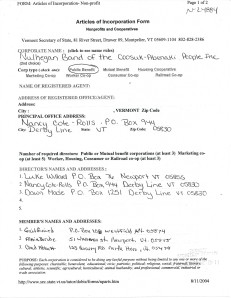
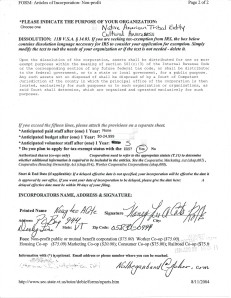
The Nulhegan incorporation was formed on August 25, 2004. The registered office/agent was Nancy Cote-Rolls (now deceased) with both Luke Andrew Willard and Dawn Macie as officers. Nulhegan is listed as a “Native American Tribal Entity” on the second page of this form. Several people are listed as members (Gail Girard, Alain Berube and Chad Abbott).
If you look at the images below, you will find a summary at the end that ties together the going-ons of this incorporation. The reader must understand where these people came from and what they are claiming in order to make sense of these facts.
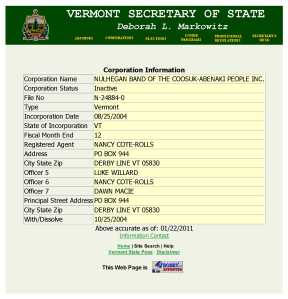
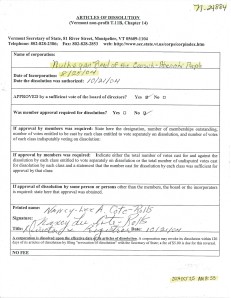
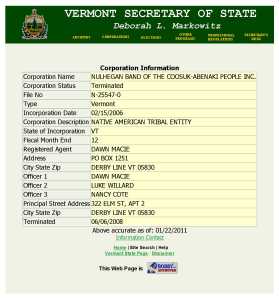
Read the images and make your own conclusions. There is more information available at the following link:
http://www.sec.state.vt.us/corps/corpindex.htm
Look up Luke Willard, Dawn Macie or any other officers of Nulhegan for results
Nancy Cote-Rolls, Luke Andrew Willard and Dawn Macie were all part of the Ralph Swett “Clan of the Hawk” incorporation and Luke Andrew Willard was a prior member (and the financial officer) for the North American People Of The Dawn group.
They don’t shy away from admitting that they are incorporated. However, if you’ll look at their incorporation documents above and follow the link as well, you’ll see that they are an “on again-off again” type of organization that was never firmly established.
(All images sourced from The Reinvention of The Alleged Vermont and New Hampshire Abenaki blog)
853 (c)(1) A majority of the applicant’s members currently reside in a specific geographic location with Vermont.
According to the tribal rolls residency information dated Sept. 13, 2010, approximately 91% of their registered citizens reside in Vermont. Approximately 75% reside within the boundaries of Nulhegan’s defined territory in the Northeast Kingdom. Approximately 62% reside in the greater Newport/Derby area around the lakes and along the rivers of the Nulhegan and Memphremagog basins.
“Chief” Donald Stevens does not reside within the Nulhegan territory. His most recent address is in Shelburne, VT. Regardless, fair enough statistics.
853 (c)(2) A substantial number of the applicant’s members are related to each other by kinship and trace their ancestry to a kinship group through genealogy or other methods.Genealogical documents shall be limited to those that show a descendancy from identified Vermont or regional Native people.
According to the tribal rolls, dated 9/13/10, there are approximately 260 full status citizens. Approximately 96% are related to other (non-nuclear) citizens by kinship. This high rateindicates a significant community with ties based substantially on kinship.
Chief Don Stevens is related by blood or marriage to at least 160 full status members.
Here’s a genealogical chart that documents Mr.Stevens ancestors (as compiled by the editor of the Reinvented Abenaki blog):
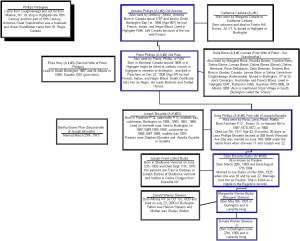
The Phillips Family Band was a major family band (kinship group) that showed their connection to people listed on the tribal rolls. Chief Antoine (Anthony) Phillips Sr. was born in 1787 at Lake Memphramagog, Vermont.
His native ethnicity and Vermont residency is validated by the
Vermont Eugenics Survey as having “French and Indian Blood” as well as being leader of a tribe. This constitutes a kinship group for purposes of this criterion.
There are several document that you should take a look at, especially those concerning both Antoine Phillips Sr. and Antoine Phillips Jr.
Below, is an image that appeared in Frederick M.Wiseman’s document, “Decolonizing the Abenaki.”
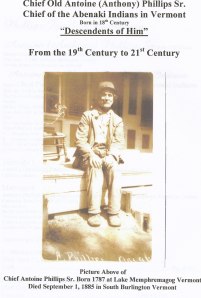
Below this, is another version of the same picture. Pay close attention to the wording on both images.
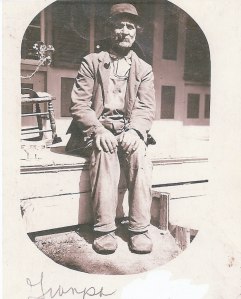
There is also a third version of this photo below:
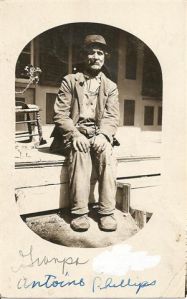
If you’ve paid attention to the writing, it is different in all three photos. Also, I’ve been told that the man in the picture is in fact Antoine Phillips Jr., not Antoine Phillips Sr. as Mr.Wiseman’s document claims.
Here are a few more documents on both men.
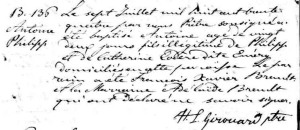
Baptismal record for Antoine Phillips Jr from the Notre Dame de Rosaire Church in St.Hyacinthe, QC. This is dated from July 1834.
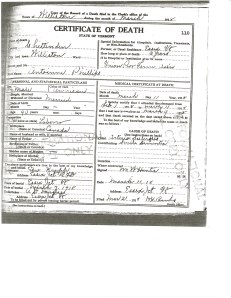
Antoine Phillips Jr. death record. This is the Antoine Phillips Jr. alleged to be in the photo above. It is dated from March 11, 1918 and lists his age as 90 years.
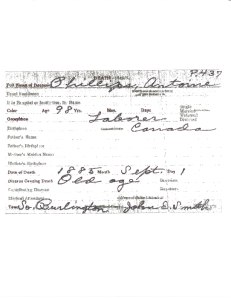
This is the death record for Antoine Phillips Sr. It is dated September 1st, 1885 and lists his age as 98 years.
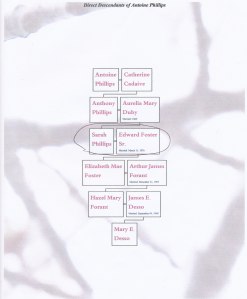
This is a descendant chart of Antoine Phillips Sr. The picture came from Elizabeth Mae Foster and “Granpa” is on it. Common sense says that the man in the photo is the grandfather of Elizabeth Mae Foster, based on the Phillips line document above. As a result, it has to be Antoine (Anthony) Phillips Jr., not Antoine Phillips Sr.
The reason for this analysis has to do with the presentation of something as “evidence”. The evidence must be just that. It must be accurate and it must be verified by historians and family members as well.
The Phillips family still resides in the Lake Memphramagog area. Chief Antoine was a direct forebear of numerous Vermont Indigenous people. His son, Pierre (Peter) Phillips (born 1809) had a daughter, Rosa Delphine Phillips (b. 1868) who had a daughter, Lillian “Delia” Bessette (b. 1909) who had a daughter, Margaretia Burbo (b. 1931) who has a son, Donald Stevens (b. 1966), who is an active memberof the Vermont Indigenous community, a former Chairman of the VT Commission on NativeAmerican Affairs, and is now the Chief of the Nulhegan Band
This does line up with the chart posted above. The only issue at hand concerns Antoine Phillips Sr. and Antoine Phillips Jr. If you have more information, feel free to come forward and discuss it.
853 (c)(3) The applicant has a connection with Native American Indian tribes and bands that have historically inhabited Vermont.
Nulhegan has a strong political connection with three other indigenous bands in Vermont,including the Elnu Abenaki Tribe from Southern Vermont, the Koaseks from the Newbury region of VT, and the St. Francis-Sokoki Band of Swanton, VT. Each of them can demonstrate that they have “historically inhabited Vermont”. They have joined together to form the Indigneous Alliance. The coalition has proven to be a great benefit to each other. The association has found genealogical connections among the bands. For instance, Nulhegan tribal citizens Nancy Cote and Dawn Macie are related to Missisquoi Tribal Historian Fred Wiseman. The Demar family has many Missisquoi relations. Tom Phillips, a descendant of Chief Phillips is a cousin to Nulhegan Chief Don Stevens. Historical connections are addressed at length in their responses to criteria 4 and 5.
I’m not sure why they chose to include this as criteria as it has absolutely nothing to do with recognizing Nulhegan and more to do with “pimping” their alliance as much as possible. Also, the majority of this application is based around Donald Warren Stevens Jr.
853 (c)(4) The applicant has historically maintained an organizational structure that exerts influence and authority over its members that is supported by documentation of the structure, membership criteria, the names and residential addresses of its members, and the methods by which the applicant conducts its affairs.
The application shows dates and locations documenting their continuous political organization.Their historic period case began with Chief Philip of the Upper Coos when he signed a document called the “Deed of the Coos Country” in 1796. David Skinas commented that, “The 18th century Nulhegan organizational structure may have been more complex than the individual family band structure that they refer to as ‘branches,’ where extended families maintain enduring collective memories and relations that work together for the common good.” This shifted to “Katunks” in the 19th and 20th centuries in which they would discuss business. The shift then moved onto their current structure representing a continuous political authority over the people.
But, the Nulhegan band was not incorporated until 2004! They are talking about things that happened decades ago, long before Luke Andrew Willard, Nancy Cote-Rolls and Dawn Macie came along!
The present government organizational structure is a standard three-branch government. The Executive Branch is Chief (Sogomo) and a Vice-Chief (Sogomis) who are nominated by the councils and confirmed by election. The Legislative Branch is composed of an elected Tribal Council of 5-13 members from various families within the tribe. The Judicial Branch is represented by an Elders Council which is an evolution from the former “Ladies Judiciary” Also in the tribe’s government is a Board of Trustees. There are three and they are entrusted with the Continuity of Government. They protect the tribal government from takeover and/or dissolution.
According to Article IV (Citizenship – General Council) of the Nulhegan constitution, all people of the greater Abenaki Nation must be blood relations as proven by genealogical and/or family historical evidence.
A link to the Nulhegan constitution can be found at the following link:
http://reinventedvermontabenaki.blogspot.com/2011/01/nulhegan-band-coosuk-abenaki.html
Here’s some information on this particular article:
Article IV. Citizenship – General Council
Section 1. All People of the greater Abenaki Nation must be Citizens or “blood relations” as proven by genealogical and or family historical evidence. All Citizens (blood relations), as a collective body, shall be called the General Council of their respective Band or group and the greater Abenaki Nation. Spouses of Citizens with Native American Indian blood and the Children from a Citizen are given Citizen status. Non-blood Spouses and adopted children of Citizens are limited to Member status. All Non-blood Members and adopted child Members shall not be included in any General Council. Adult adoptions are not authorized or recognized for Citizen or Member status.
I love how they act like the founding fathers of this country. I have to admit, for a questionable group of people, they are well organized in this area. Greater Abenaki nation? Who do they think they are? The St.Francis/Sokoki band?
Section 2. There shall be established a Citizen and Member Register, to be kept by the Grand Council (of each Abenaki Band or group) or Registrar, for the inclusion of any person for Citizenship or Membership purposes in their respective Band or group and the greater Abenaki Nation, who presents the necessary evidence of eligibility for registration. Each Abenaki Band or subgroup shall establish a Registration Committee. It shall be the duty of the Registration Committee to consider the qualifications and to determine the eligibility of those applying to have their names entered in their Band or group and the Abenaki National Register. The Registration Committee shall consist of one (1) Grand Council member, one (1) Council of Elders member, one (1) General Council member, a Registrar, one (1) or more Genealogist, and one (1) or more Historian. All members of the Registration Committee shall be appointed by the Kchi Sag8mo, and confirmed by the Grand Council of each Band or group of the greater Abenaki Nation.
A. There shall be a number assigned to every name which is approved and entered into the Abenaki National Register. This number shall be preceded by a letter or other notation to signify “blood” Citizens, “non-blood” Member relations or adopted Child Members. The suggested notation is the letter “C” for blood Citizens or the letter “M” for Members.
Is this “Abenaki National Register” included as part of their evidence? I’ve never heard of such a thing and once again, they are pretty damn crafty.
B. The decisions of the Registration Committee shall be subject to review by the Abenaki Band or group Grand Council.
Section 3. Registration as used in this article refers to the process of enrolling as a Citizen or Member of the Abenaki Nation and is not the same as the registration for voting purposes.
There shall be established Citizen and Member Register, to be kept by the Grand Council or Registrar for the inclusion of any person for Citizenship or Membership purposes in their respective band or group and the greater Abenaki Nation, who presents the necessary evidence of eligibility for registration. Registration Committee shall consist of one Grand Council Member, one Council of Elders Member, one General Council Member, a registrar, one or more genealogist, and one or more historians.
Again, crafty and clever. You can view the rest of this constitution at the link above.
The Nulhegan Band has presented information needed for 853 (c)(4), including the history of organizational structure, the “Government of the Abenaki Tribe at Nulhegan-Memphremagog”, excerpt sections from the Nulhegan Band Constitution, the application form to become a member, the names and residential addresses of its members, and Article II (Decision making)shows the documentation of the methods by which the applicant conducts its affairs.
You can find information on Article II as well below:
Article II. Decision Making
Section 1. All acts of the Abenaki Citizens shall be conducted and decisions made through traditional “Longhouse” consensus decision making. Consensus decision making is as follows:
Consensus:
General agreement;
Judgment arrived at by most of those concerned;
Group solidarity in sentiment and belief.
To make a decision that is in the best interests of all the People. Consensus does not mean that all agree, but that all understand the decisions.
Approach:
In entering the Consensual Decision-Making Process, whatever ideas are put into the process, the needs and attitudes of each are considered to complement the decision. Also, individuals have a duty to be directly involved, and to bring their ideas into the discussion within their group.
The final decision may be fully satisfactory to some, satisfactory to others, relatively satisfactory to most, and possibly un-satisfactory to someone. This is a slow and careful process requiring the full understanding by each individual, not a decision made by a “leader,” but it will be a decision that reflects elements from each group.Roles:
Within any collective group of People, whether it is a Family, Clan, Group, Band, Tribe, Nation, or Confederation, equitable representation must be given to all groups. Spokes people are usually chosen from the smallest groups within the greater group. This may be the male or female head of a family, clan speaker, matriarch, elder, band chief, or whatever leader or spokesperson is chosen to speak for each group.
An impartial “Facilitator” (Speaker, Arbiter, Elder) should be chosen from the greater group gathered. This person is selected because of their ability and respect as an elder or leader. Their role is to provide control and order to assure that collective rational thought and behavior are followed to come to an agreement.
Process:
The smaller groups within the larger group of people will deliberate on an issue or matter. The leader of each smaller group reports their decision to the “Facilitator” If the smaller groups disagree, or there is an error or irregular proceeding the “Facilitator” will ask that they deliberate again. This process may need to be repeated until the “Facilitator” believes that all understand and the issue is agreed upon.
Three Truths:
When an issue is discussed, the groups consider the good and bad parts of the issue. The following “Three Truths” must be met for consensus:
1. Peace – Does it preserve the peace that is already established?
2. Righteousness – Is it morally correct?
3. Power – Does it preserve the present and future integrity of the group?
a. Present – What does it do for the present generation?
b. Future – How does it affect the future seven generations from now?
The decisions made today must benefit all the people from the present to the seven generations into the future.
Deliberations:
Persons are asked throughout the process if they fully understand. If not, the process stops until this is accomplished. One cannot simply be stubborn and refuse to understand as they will be questioned. Each must follow the Truths of Peace, Righteousness and Power at all times.
Every person has a responsibility to expand and exercise their minds. The forces of life have given the human being the potential to use the mind to create a better life through Peace, Righteousness and Power.
Decision-Making Process
> All opinions have to be considered;
> All must be completely reasonable;
> All should come with an open mind;
> All must fully understand the other’s viewpoint;
> Each participant cannot repeat a position once it has been fully explained and understood;
> A person who does not agree with the views stated must fully explain their dissenting views;
> No one can impose their will nor make a decision for another;
> All must understand the viewpoint and agree of their own free will;
> If there is no consensus, the consensus is to retain the existing position on the issue.
Again, very crafty. I think that they may have copied this information from another constitution. Regardless,it’s interesting.
853 (c)(5) The applicant has an enduring community presence within the boundaries of
Vermont that is documented by archaeology, ethnography, physical anthropology, history,
folklore, or any other applicable scholarly research and data.
The Nulhegan band petition presents a solid case for continuous occupation, especially during the years from 1780 to present. They used important anthropological, census data, historical (written and oral), geographic, legal (deeds), Eugenic records, art, and ethnographic sources including work by William Haviland, Frederick Wiseman, Colin Calloway, Gordon Day, Mariella Squier, etc. In several places, the authors expressed the reality that there has been little written and therefore some of the information has yet to be verified by scholarly sources.
There are pitfalls involved if one is to rely solely on the eugenics records, legal deeds and so forth. Regardless, if there was NO actual Nulhegan band/tribe during that time, how can they use this information to prove just who they are? This part does not make much sense to me.
Much of the application focuses on information sourced mostly by several books/authors. They say that they have oral records, etc as well. Still, was there an actual Nulhegan tribe/band during the following time period (1780-2004)?
They identify the 1796 “Deed of the Coos Country” as an important historical marker in which they signed over legal land ownership but maintained fishing rights and crops from the region forever.2 Importantly, this stipulation certainly identifies both the existence of Abenaki people. previous to and contemporaneous to the deed. It also represents their intention and as the rest of the petition exhibits, their continual occupation within the territory.
More on this specific deed is documented below.
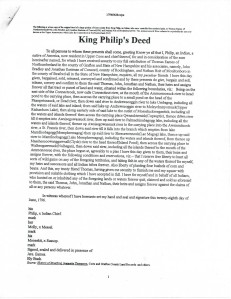
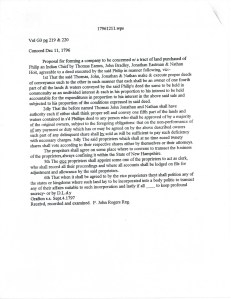
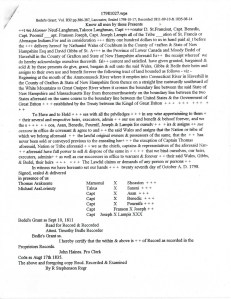
Ok, to exercise a bit of common sense here, why are they using a land deed from Coos County, NH as proof of their ties to Phillip? Well, by reading the first page, you will see that Lake Memphremagog, the Clyde River, the town of Island Pond and “Nulhegan” are mentioned as part of this deed. This land was purchased from Phillip. At least this part is clear on the surface.
If they had no intention of staying, they would not have needed the stipulation that they were allowed to maintain fishing and other rights within the region. This deed was signed by “Philip” the chief, Molley Messel, and Mooselek Sussop.
Indeed it was signed by them as documented above.
One of the most interesting parts of this section is that they do not simply present the deed and the people but they tie Chief Philip to modern people within their own oral history as descendents.
I don’t think this is enough “proof”. Short of exhuming the bodies of the people who were present at the time of this transaction, there really isn’t much else you can do to prove anything. You could rely solely on books and scholars but you would be missing the extra information.
Though it would have been nice to have a specific source for this oral information, it is very difficult to follow the exchange of memory back more than two hundred years but a specific person with this information may have been useful.
Indeed. If they openly admit this, then how could they pass muster for recognition?
This certainly highlights the sometimes large gulf between the way that indigenous people view and understand history and the dominant history methods used in academia.There is value in both.
Both are necessary in order to link euro-centric history records with those of indigenous oral history. Hence, this application is incomplete in a way.
Furthermore, they supplied an impressive copy of the “Indian Encampment, Lake Memphramagog” by Cornelius Krieghoff done in 1854 as evidence of nineteenth century occupation within the region.
The Koasek also use this painting as “proof” of their existence during this time period. The painting itself does not specify WHICH indian band/tribe is occupying this encampment. How can two groups use the SAME painting as evidence when the artist has not specified who is occupying that encampment? The painting is below and it was found on the Koasek’s webpage (http://cowasuck-abenaki.com/history.html)
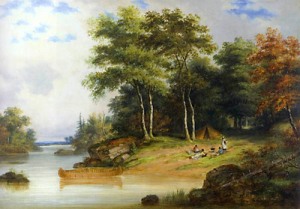
Other items were presented as “evidence”. This information isn’t available to me. Regardless, it’s more interesting to wonder just who was camping in the painting. I just do not think that the Nulhegan and Koasek groups should use this as “evidence” because it is a painting, not oral history and certainly not written history.
Although genealogy was not a part of the purview of the commission, their petition did a very nice job of explaining historical ties to specific families and people. They importantly used Chief Antoine Phillips’ (born in 1787) records. A tin-type photo of this person housed at the Wobanakik Heritage Center listed him as chief and the Eugenics records validated the French and Indian blood of this specific line and they provide the necessary source material for this
assertion.
You have Hinda Miller to thank for the part discounting genealogy, which is a shame. It opens the doors to just about anyone with a PH.D to invent tribes and histories. I already wrote about the tin-type photo of Antoine Phillips Jr. (not Sr. as they claim!). I have no comment on the eugenics records as I do not have access to them. This was certainly a terrible time for native people in the state of Vermont. However, one should not rely strongly on these records if looking for proof of existence.
One of the most important aspects of the petition was the demonstration that they inherited a cultural tradition separate from the Euro-American community and continue to practice these traditions.
They would like it if people didn’t let the “white” on their birth certificates get in the way of recognizing them as indians.
Snow descendants are included throughout the petition to bring to light their unique indigenous practices, such as sugaring, mound horticulture, and Nancy Snow’s story. This continuous family line and their activities is extremely convincing and sets them apart as indigenous peoples. There isn’t just one activity in one time by a member of the family, they documented continuous activities that put together are expressive of their heritage.
Which Nancy Snow? The Nancy Snow (white) that married Norris Batchelder (also white)? Or the Nancy Snow from 1850 that lived at St.Regis? There are two Nancy Snows and they need to be more specific when mentioning either of them.
They also had a unique fancy basket tradition in the form of an over-weave cherry root design motif in the early nineteenth century.25 What is particularly important about this tradition is that it is not only unique to the region according to both John Moody and Dr. Frederick Wiseman but if this is documented to the early twentieth century then that means there was a continued presence through at least the early twentieth century. At a time that is particularly important for recognition purposes to prove that people were in Vermont, Nulhegan shows a continued agricultural, cultural, and genealogical settlement within the region.
Oh boy, a mention of both John Moody and Fred M. Wiseman in the same sentence? Using a method that is unique to a region as “evidence” is not specific enough. Is it unique to the Nulhegan people only? Or did other natives in the area use it as well? I could go on and on and on but it would not be of much help in this analysis. Read it for yourself and follow the links mentioned in the footnotes. There are enough holes in this “evidence” that should be enough for it to be thrown out.
853 (c)(6)(A) The applicant is organized in part: to preserve, document, and promote its Native American Indian culture and history, and this purpose is reflected in its bylaws.
Nulhegan used the preamble of their constitution to satisfy this requirement. Their “mission is to strengthen our government, protect our customs and traditions, and revive our heritage and culture while sharing it with those around us.” Nulhegan has done a great job of exemplifying this throughout the petition and their letters show a positive impact on the Vermont community.
I’ll be quite frank here: It should be to “harm, distort and steal native american culture.” If it was, then yes, the Nulhegan group has done a great job. Not bad for a 7 year old group claiming to have 18th century roots.
853 (c)(6)(B) The applicant is organized in part: to address the social, economic, political or cultural needs of the members with ongoing educational programs and activities.
Nulhegan satisfied this requirement by quoting the preamble to their constitution and also taking an excerpt from their website, “The Nulhegan is serious about achieving economic self-sufficiency and stability for our people … our sights are set upon utilizing our own resources and abilities to grow in the realm of economic development, more specifically, cottage industry and cultural tourism.”
This could be interpreted to mean literally anything in the way of economic development. If they wanted to build a casino, I doubt the state could do much. If they wanted to try and honor an 18th century land deed, well ditto.
They also actively seek Title VII Indian Education in their school systems in order to assist in proper educational programming, as has been described in several letters of support in the application.
Proper educational programming in this sense means an Alliance-centric view of Vermont Abenaki history. They want to be able to shut out Odanak and any other native communities (if they exist) in the state of Vermont so that their history will dominate textbooks. This is patently wrong and grossly unfair. The state of Vermont doesn’t seem to care.
They also seek achievement of political recognition for the people and many members work toward this effort, including two chairmen of the VCNAA – Don Stevens and Luke Willard.
To my knowledge, Donald Stevens Jr. never stumped for the Nulhegan people while chairman of the VCNAA. If he did, it was behind closed doors. It’s no secret that he is allied with Luke Willard, current VCNAA chairman. How else would he have become the Nulhegan chief? Both men were instrumental in libelous email communications, mostly about “unity”. It’s unfortunate that the state of Vermont has blinders when it comes to recognizing such sleazy dealings. If you read the postings of an user named “Gluscabi” on this blog, he/she claims that the Elnu (and quite possibly Nulhegan and Koasek) groups do not want political recognition. This is patently untrue because they are kissing up to politicians and the Vermont media in hopes of winning recognition.
853 (c)(9)(A) Submission of letters, statements, and documents from: municipal, state, or federal authorities that document the applicant’s history of tribe-related business and activities.
Nulhegan included letters from the Newport City Council, a letter documenting their participation and integral membership of the Vermont Indigenous Alliance, newspaper article from the Newport Daily Express discussing the intent to gain recognition in 2002, a letter from the Green Mountain Central Labor Council of the AFL-CIO, a letter from the Vermont Sierra Club, a letter from the Vermont Workers’ Center, a letter from the Vermont Professional Archaeologists Association, etc. Several of the letters including Senator Hinda Miller, Representative Carolyn Branagan, Representative Kate Webb, former Lieutenant Governor Brian Dubie, and Governor Peter Shumlin show a continued positive relationship with senators, legislators, and members of the executive branch. Governor Douglas in November of 2010 issued a proclamation of Native American Heritage Month and specifically mentioned Nulhegan
as people indigenous to the state. These letters exemplify their continuous presence within the political realm, in conservation efforts, and their efforts to educate children in a positive way that would support their own identity.
None of these letters mean anything in the long run. Politicians are endorsed by the AFL-CIO all the time. Ditto on wasteful proclamations like those made by former governor Jim Douglas. Governor Shumlin, like his predecessor, could probably care less about the outcome of this issue. Ditto on Hinda Miller. This is just a problem with the criteria itself and not something that you can blame on the actual groups, unless they were involved in the formation of said criteria.
853 (c)(9)(B) Submission of letters, statements, and documents from: tribes in and outside
Vermont that attest to the Native American Indian heritage of the applicant.
They included a letter documenting their participation and integral membership of the Vermont Indigenous Alliance; newspaper article from the Newport Daily Express discussing the intent to gain recognition in 2002; a letter from the Elnu Abenaki Tribe of Jamaica, VT; a letter from the Koasek Abenaki of the Koas in Newbury, VT; and a letter from the Koasek Traditional Band of the Sovereign Abenaki Nation in Milford, NH. These letters exemplify their continuous
presence within the political realm and social realm of the Native American community. David Lacy commented that “…It is encouraging to see the mutual respect, support and solidarity offered by other members of the Vermont Indigenous Alliance.”
Wait a minute? Attempt to gain recognition in 2002? But, they became an incorporation in 2004! This has to be a typo or perhaps there is something that they are not telling us. It’s really too bad that they couldn’t get a letter from a tribe outside of Vermont (Koasek Traditional Band does not count). Are we to assume that said tribes outside of Vermont do not recognize the Nulhegan people? What does this tell you, the reader, about these people?
I hope you will read this and draw your own conclusions. In my honest opinion, I do not think that the Nulhegan group should be recognized in the state of Vermont for obvious reasons. However, I do not have much of a say in this. That is perfectly fine. It’s important that the people know what’s going on and someone has to point out the inaccuracies, etc that make up these applications.
Feel free to offer constructive dialogue if you so disagree. Tell me why the Nulhegan people should be recognized.

























